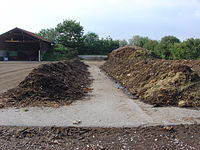
Photo from wikipedia
Fly ash application to the soil at lower doses with organic substrates has been advocated by researchers due to its beneficial soil ameliorative properties. But its xenobiotic effects in presence… Click to show full abstract
Fly ash application to the soil at lower doses with organic substrates has been advocated by researchers due to its beneficial soil ameliorative properties. But its xenobiotic effects in presence of vermicompost have not yet been studied fully. The hypothesis of the present study was to ascertain the ameliorative effects of fly ash and vermicompost amendment on the soil nematode and earthworm count and change in the soil carbon pool of the rice nursery. The native soil, fly ash, and vermicompost at 0%, 20%, 40%, 60%, 80%, and 100% combinations (by weight) in triplicate were investigated under a factorial complete randomized design. The fly ash affected the earthworm survivability to an extent that the earthworms could not survive in fly ash of concentration greater than 20%. On the contrary, the concentration of vermicompost positively influenced the earthworm and nematode count in the rice rhizosphere. The population of nematodes viz. Rhabditis terricola and Dorylaimids in the rhizosphere of rice nursery was positively linked with the vermicompost concentration, while fly ash had antagonistic effects. The absence of nematodes and earthworms at a higher concentration of fly ash could be linked to the xenobiotic effects of fly ash. However, on mild addition of fly ash and vermicompost (20% each) to the native soil, the carbon stock increased positively to the maximum extent due to the larger surface area of fly ash and its xenobiotic effects limiting respirational carbon loss.
Journal Title: Environmental Science and Pollution Research
Year Published: 2022
Link to full text (if available)
Share on Social Media: Sign Up to like & get
recommendations!